sensor PEUGEOT 4008 2017 Owners Manual
[x] Cancel search | Manufacturer: PEUGEOT, Model Year: 2017, Model line: 4008, Model: PEUGEOT 4008 2017Pages: 368, PDF Size: 12.22 MB
Page 4 of 368
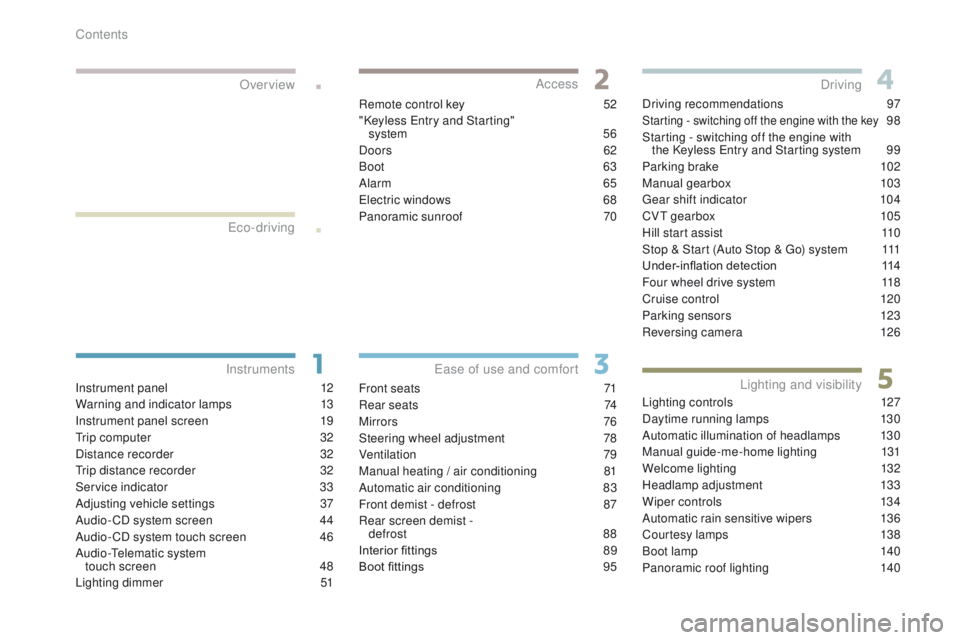
.
.
4008_en_Chap00a_sommaire_ed01-2016
Instrument panel 12
Warning and indicator lamps
1
3
Instrument panel screen
1
9
tr
ip computer
3
2
Distance recorder
3
2
tr
ip distance recorder
3
2
Service indicator
3
3
Adjusting vehicle settings
3
7
Audio- CD system screen
4
4
Audio- CD system touch screen
4
6
Audio-
te
lematic system
touch screen
4
8
Lighting dimmer
5
1Remote control key
5
2
"Keyless e
n
try and Starting"
system
5
6
Doors 62
Boot
6
3
Alarm
65
el
ectric windows
6
8
Panoramic sunroof
7
0
Front seats 7 1
Rear seats
7
4
Mirrors
76
Steering wheel adjustment
7
8
Ventilation
7
9
Manual heating / air conditioning
8
1
Automatic air conditioning
8
3
Front demist - defrost
87
R
ear screen demist - defrost
88
Interior fittings
8
9
Boot fittings
9
5Driving recommendations
9
7
Starting - switching off the engine with the key 98
S
tarting - switching off the engine with the Keyless
e
n
try and Starting system
9
9
Parking brake
1
02
Manual gearbox
1
03
ge
ar shift indicator
1
04
CV
t
gearbox
1
05
Hill start assist
1
10
Stop & Start (Auto Stop &
g
o
) system
1
11
Under-inflation detection
1
14
Four wheel drive system
1
18
Cruise control
1
20
Parking sensors
1
23
Reversing camera
1
26
Lighting controls
1
27
Daytime running lamps
1
30
Automatic illumination of headlamps
1
30
Manual guide-me-home lighting
1
31
Welcome lighting
1
32
Headlamp adjustment
1
33
Wiper controls
1
34
Automatic rain sensitive wipers
1
36
Courtesy lamps
1
38
Boot lamp
1
40
Panoramic roof lighting
1
40
Over view
e
co-driving
Instruments Access
ea
se of use and comfort Driving
Lighting and visibility
Contents
Page 6 of 368
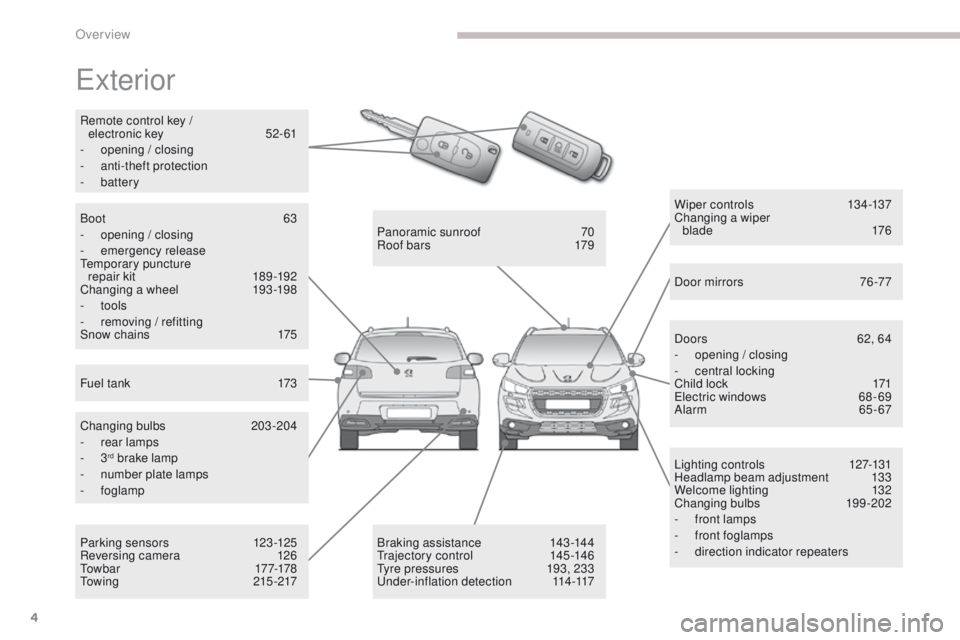
4
4008_en_Chap00b_vue-ensemble_ed01-2016
exterior
Lighting controls 127-131
Headlamp beam adjustment 1 33
Welcome lighting
1
32
Changing bulbs
1
99-202
-
f
ront lamps
-
f
ront foglamps
-
d
irection indicator repeaters
W iper c ontrols
13
4 -137
Changing a wiper b l a d e
17
6
Door mirrors
7
6 -77
Doors
6
2, 64
-
ope
ning / closing
-
c
entral locking
Child lock
1
71
el
ectric windows
6
8 - 69
Alarm
65-67
Panoramic sunroof
7
0
Roof bars
1
79
Braking assistance
1
43-144
tra
jectory control
1
45-146
ty
re pressures
1
93, 233
un
der-inflation detection
1
14-117
Boot
63
-
ope
ning / closing
-
em
ergency release
te
mporary puncture
repair kit
1
89-192
Changing a wheel
1
93-198
-
tools
-
r
emoving / refitting
Snow chains
1
75
Changing bulbs
2
03-204
-
r
ear lamps
-
3rd brake lamp
-
n
umber plate lamps
-
foglamp
Parking sensors
1
23-125
Reversing camera
1
26
to
w b a r
17 7-178
to
wing
215 -217
Fuel tank
1
73
Remote control key /
electronic key
5
2-61
-
ope
ning / closing
-
a
nti-theft protection
-
battery
Over view
Page 10 of 368

8
4008_en_Chap00b_vue-ensemble_ed01-2016
A. Passenger's airbag deactivation warning lamp 1 52
B.
H
azard warning lamps
1
42
C.
F
ront passenger's seat belt not fastened
or unfastened warning lamp
1
48
Central switch panel
Instruments and controls (continued)
A. Manual headlamp adjustment 133
B. D eactivation of the ASC/tC L system 1 45
C.
D
eactivation of the parking
sensors
125
D.
D
eactivation of the Stop & Start
(Auto Stop &
g
o
) system
1
12
Side switch panel
Over view
Page 17 of 368
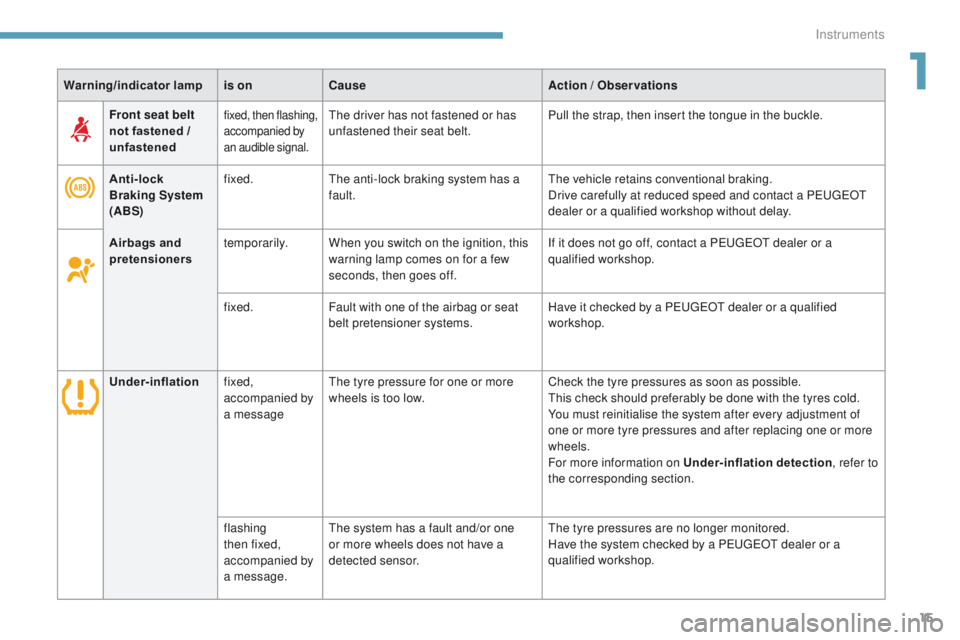
15
4008_en_Chap01_Instruments-de-bord_ed01-2016
Warning/indicator lampis on Cause Action / Observations
Anti-lock
Braking System
(ABS) fixed.
th
e anti-lock braking system has a
fault.
th
e vehicle retains conventional braking.
Drive carefully at reduced speed and contact a P
e
uge
Ot
dealer or a qualified workshop without delay.
Front seat belt
not fastened /
unfastened
fixed, then flashing,
accompanied by
an audible signal.the driver has not fastened or has
unfastened their seat belt.
Pull the strap, then insert the tongue in the buckle.
Airbags and
pretensioners temporarily.
When you switch on the ignition, this
warning lamp comes on for a few
seconds, then goes off. If it does not go off, contact a P
e
uge
Ot
dealer or a
qualified workshop.
fixed. Fault with one of the airbag or seat
belt pretensioner systems. Have it checked by a P
e
uge
Ot
dealer or a qualified
workshop.
Under-inflation fixed,
accompanied by
a message
th
e tyre pressure for one or more
wheels is too low. Check the tyre pressures as soon as possible.
th
is check should preferably be done with the tyres cold.
You must reinitialise the system after every adjustment of
one or more tyre pressures and after replacing one or more
wheels.
For more information on Under-inflation detection , refer to
the corresponding section.
flashing
then fixed,
accompanied by
a message.
th
e system has a fault and/or one
or more wheels does not have a
detected sensor.
th
e tyre pressures are no longer monitored.
Have the system checked by a Peuge
O
t dealer or a
qualified workshop.
1
Instruments
Page 26 of 368

24
Screen 1 Screen 2Cause Solution - ActionObservations
th
e brake fluid level is too low.
to
p up using a brake fluid listed by
P
e
u g e
Ot
.If the problem persists, contact a
P
e
uge
Ot
dealer or a qualified
workshop.
Fault with the braking system. You must stop as soon as it is safe to do so.Have the system checked by a
P
e
uge
Ot
dealer or a qualified
workshop.
Fault with the anti-lock braking
system (ABS). Contact a P
e
uge
Ot
dealer or a
qualified workshop.
th
e vehicle retains conventional
braking without assistance but you
are advised to stop.
th
e tyre pressure is too low in one
or more tyres. Check the tyre pressures as soon
as possible.
th
is check should preferably
be done with the tyres cold.
You must reinitialise the system
after adjusting one or more tyre
pressures or after changing one or
more wheels.
For more information on the Under-
inflation detection system , refer
to the corresponding section. If the problem persists, contact a
Peuge
O
t dealer or a qualified
workshop.
th
ere is a fault with the under-
inflation detection system and/or
at least one wheel does not have a
detected sensor.
th
e tyre pressures are no longer
monitored.
Have the system checked by a
P
e
uge
Ot
dealer or a qualified
workshop.
Instruments
Page 45 of 368
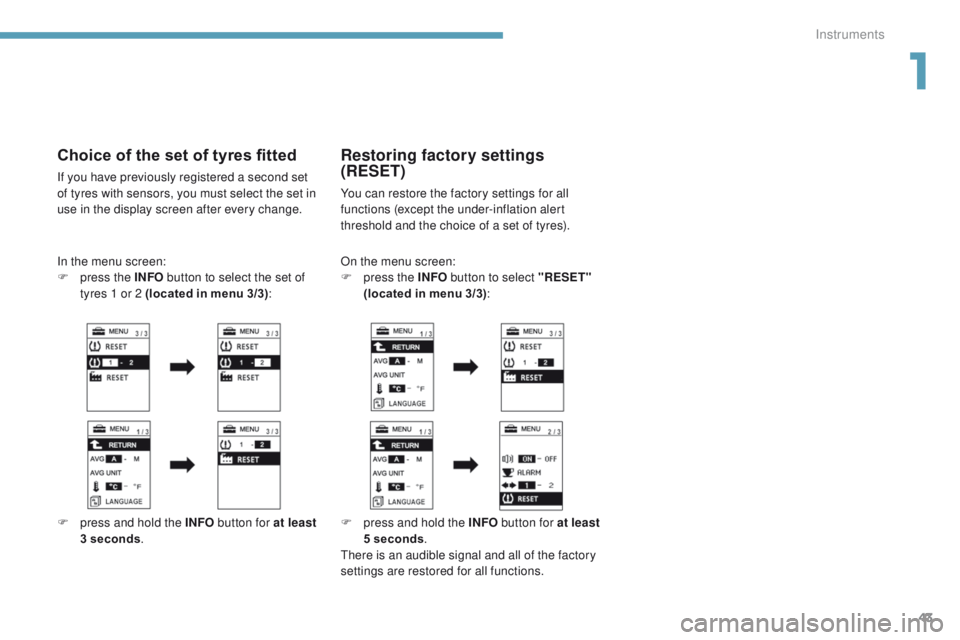
43
4008_en_Chap01_Instruments-de-bord_ed01-2016
Choice of the set of tyres fitted
If you have previously registered a second set
of tyres with sensors, you must select the set in
use in the display screen after every change.
Restoring factory settings
(RESET)
You can restore the factory settings for all
functions (except the under-inflation alert
threshold and the choice of a set of tyres).
In the menu screen:
F
p
ress the INFO button to select the set of
tyres 1 or 2 (located in menu 3/3) :On the menu screen:
F
p
ress the INFO button to select "RESET"
(located in menu 3/3) :
F
p
ress and hold the INFO button for at least
3 seconds . F
p
ress and hold the INFO button for at least
5 seconds .
th
ere is an audible signal and all of the factory
settings are restored for all functions.
1
Instruments
Page 80 of 368

78
4008_en_Chap03_Ergonomie-et-confort_ed01-2016
Rear view mirror
equipped with an anti-dazzle system, which darkens the mirror glass and reduces the nuisance to
the driver caused by the sun, headlamps from other vehicles...
Manual model
Adjustment
F A djust the mirror so that the glass is
directed correctly in the "day" position.
In order to ensure optimum visibility
during your manoeuvres, the mirror
lightens automatically when reverse
gear is engaged.
Day / night position
F
P
ull the lever to change to the "night" anti-
dazzle position.
F
P
ush the lever to change to the normal
"day" position.
Automatic "electrochrome"
model
this system automatically and progressively
changes between the day and night uses by
means of a sensor, which measures the light
from the rear of the vehicle.
Steering wheel adjustment
F When stationary , lower the control lever
to release the steering wheel adjustment
mechanism.
F
A
djust the height and reach to suit your
driving position.
F
P
ull the control lever to lock the steering
wheel adjustment mechanism.
As a safety precaution, these
operations should only be carried out
while the vehicle is stationary.
Ease of use and comfort
Page 81 of 368
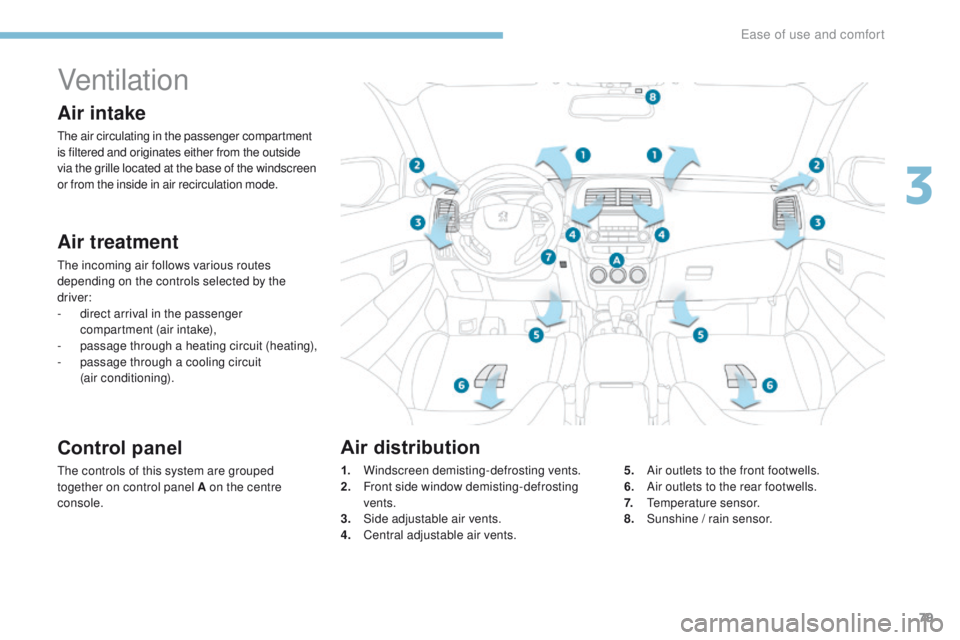
79
4008_en_Chap03_Ergonomie-et-confort_ed01-2016
Ventilation
Air intake
the air circulating in the passenger compartment
is filtered and originates either from the outside
via the grille located at the base of the windscreen
or from the inside in air recirculation mode.
Air treatment
the incoming air follows various routes
depending on the controls selected by the
driver:
-
d
irect arrival in the passenger
compartment (air intake),
-
p
assage through a heating circuit (heating),
-
p
assage through a cooling circuit
(air conditioning).
Control panel
the controls of this system are grouped
together on control panel A on the centre
console. 1. W
indscreen demisting-defrosting vents.
2. F ront side window demisting-defrosting
vents.
3.
S
ide adjustable air vents.
4.
C
entral adjustable air vents.5. A
ir outlets to the front footwells.
6. A ir outlets to the rear footwells.
7.
t
em
perature sensor.
8.
S
unshine / rain sensor.
Air distribution
3
ease of use and comfort
Page 82 of 368
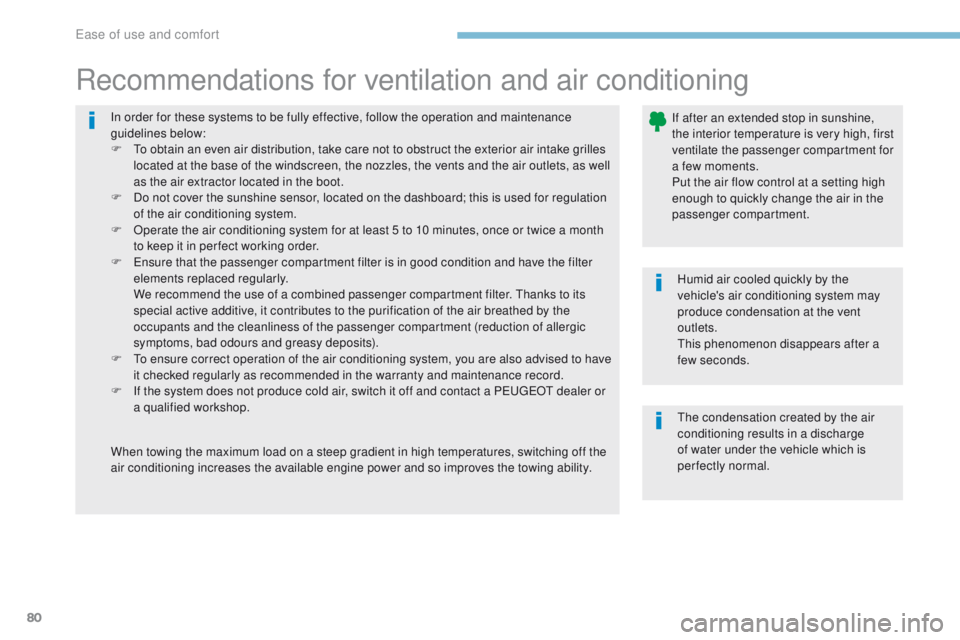
80
4008_en_Chap03_Ergonomie-et-confort_ed01-2016
In order for these systems to be fully effective, follow the operation and maintenance
guidelines below:
F t
o o
btain an even air distribution, take care not to obstruct the exterior air intake grilles
located at the base of the windscreen, the nozzles, the vents and the air outlets, as well
as the air extractor located in the boot.
F
D
o not cover the sunshine sensor, located on the dashboard; this is used for regulation
of the air conditioning system.
F
O
perate the air conditioning system for at least 5 to 10 minutes, once or twice a month
to keep it in per fect working order.
F
e
n
sure that the passenger compartment filter is in good condition and have the filter
elements replaced regularly.
W
e recommend the use of a combined passenger compartment filter. t
h
anks to its
special active additive, it contributes to the purification of the air breathed by the
occupants and the cleanliness of the passenger compartment (reduction of allergic
symptoms, bad odours and greasy deposits).
F
t
o e
nsure correct operation of the air conditioning system, you are also advised to have
it checked regularly as recommended in the warranty and maintenance record.
F
I
f the system does not produce cold air, switch it off and contact a P
e
uge
Ot
dealer or
a qualified workshop.
Recommendations for ventilation and air conditioning
If after an extended stop in sunshine,
the interior temperature is very high, first
ventilate the passenger compartment for
a few moments.
Put the air flow control at a setting high
enough to quickly change the air in the
passenger compartment.
Humid air cooled quickly by the
vehicle's air conditioning system may
produce condensation at the vent
outlets.
th
is phenomenon disappears after a
few seconds.
When towing the maximum load on a steep gradient in high temperatures, switching off the
air conditioning increases the available engine power and so improves the towing ability.
th
e condensation created by the air
conditioning results in a discharge
of water under the vehicle which is
perfectly normal.
ease of use and comfort
Page 116 of 368
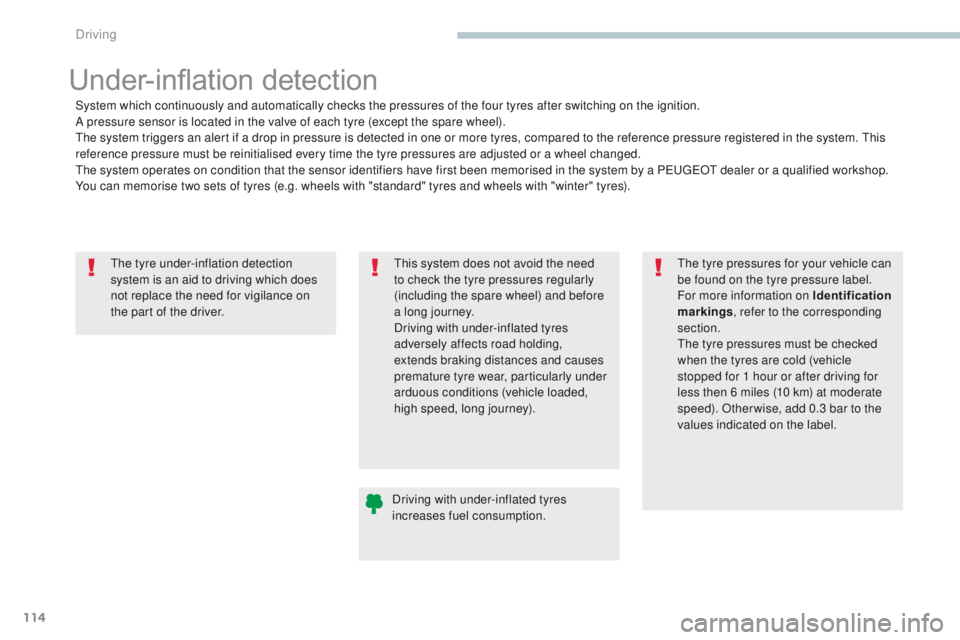
114
4008_en_Chap04_conduite_ed01-2016
the tyre under-inflation detection
system is an aid to driving which does
not replace the need for vigilance on
the part of the driver.
Under-inflation detection
System which continuously and automatically checks the pressures of the four tyres after switching on the ignition.
A pressure sensor is located in the valve of each tyre (except the spare wheel).
th
e system triggers an alert if a drop in pressure is detected in one or more tyres, compared to the reference pressure registered in the system. t
h
is
reference pressure must be reinitialised every time the tyre pressures are adjusted or a wheel changed.
th
e system operates on condition that the sensor identifiers have first been memorised in the system by a P
e
uge
Ot
dealer or a qualified workshop.
You can memorise two sets of tyres (e.g. wheels with "standard" tyres and wheels with "winter" tyres).
Driving with under-inflated tyres
increases fuel consumption.
th
is system does not avoid the need
to check the tyre pressures regularly
(including the spare wheel) and before
a long journey.
Driving with under-inflated tyres
adversely affects road holding,
extends braking distances and causes
premature tyre wear, particularly under
arduous conditions (vehicle loaded,
high speed, long journey).
th
e tyre pressures for your vehicle can
be found on the tyre pressure label.
For more information on Identification
markings , refer to the corresponding
section.
th
e tyre pressures must be checked
when the tyres are cold (vehicle
stopped for 1 hour or after driving for
less then 6 miles (10 km) at moderate
speed). Other wise, add 0.3 bar to the
values indicated on the label.
Driving